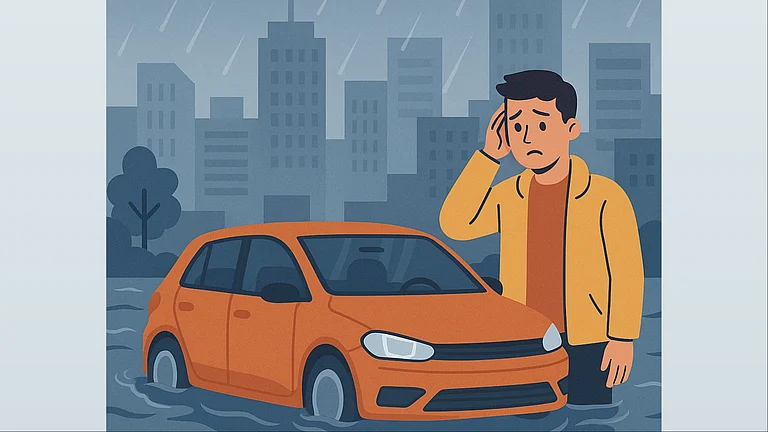
Summary of this article
Engine damage after trying to start a waterlogged car is usually not covered under a standard comprehensive policy, as insurers see it as contributory negligence.
Here are some useful add-ons like the Engine and Gearbox Protect Cover that can be helpful during floods, but even with these, claims can be rejected if the car is deliberately started in deep water.
Experts stress that while add-ons strengthen coverage, responsible driver behaviour during floods is equally important.
Every monsoon, images of half-submerged cars on city roads remind us of just how vulnerable vehicles are during floods. For many car owners, the bigger worry comes after the waters recede: will the insurance policy step in if the engine gets damaged? The answer is not as straightforward as most may assume.
According to Mayur Kacholiya, head, motor product, Go Digit General Insurance, a standard comprehensive policy does not usually cover damage to the engine if the driver attempts to start the vehicle while it is waterlogged. “Engine damage from trying to start your car in a flooded area is unlikely to be covered by a standard comprehensive policy. This is because attempting to start a submerged vehicle can be seen as contributory negligence, meaning your actions directly contributed to the damage, which often leads to claim rejection,” he explains.
That distinction between damage caused directly by natural calamities versus damage triggered by human action is key. Many policyholders don’t know, but claims may not pass in cases where water enters some specific parts of the car, such as the gearbox, and these parts are excluded from the base policy.
Moreover, any pre-existing damage also stays outside the coverage area. Kacholiya says that policyholders should carefully check the exclusions in the policy document to avoid unpleasant surprises later.
So, how can you ensure a broader coverage? This is where motor insurance add-ons come into the picture. For instance, the engine and gearbox protective cover is a critical component that can add a layer of safety for engines.
“Water ingress into the engine, a common occurrence during floods, can lead to significant and expensive repairs. This add-on specifically covers such situations, providing financial protection for engine damage due to waterlogging,” says Kacholiya. However, he cautions that even this cover has its limits: if you knowingly drive through deep water or try restarting the car after it has been submerged, the insurer may still treat it as negligence.
When it comes to urban flooding, a regular comprehensive policy can leave some big gaps, so insurers often advise looking at extra protection such as ‘Return to invoice’ cover. This add-on helps if your car is declared a total loss, in this case instead of getting only the depreciated value, the coverage will provide you to recover the full invoice price of the vehicle that may also include registration and road tax.
Another popular cover that becomes handy in heavy rains is Roadside Assistance. Cars often break down in flooded stretches, sometimes the battery dies, sometimes it is a flat tyre, or you just can’t get the vehicle moving. Having 24/7 support for towing or on-the-spot help means you are not left stranded in the middle of a waterlogged road.
Beyond these, there are more minor but important add-ons such as Zero Depreciation Cover which ensures you don’t have to pay from your pocket for the depreciation value of replaced parts during repairs.
Next is the Consumable Cover that helps with costs like lubricants, coolants, or engine oil, which a standard policy usually ignores. For those driving electric cars, an EV Shield add-on is also being offered by insurers to take care of flood-related damage to critical EV components.
Still, insurance is only one part of the equation. As Mayur Kacholiya points out, “While these covers offer valuable protection against common and costly risks, responsible action on your part is still key.” In other words, the best safeguard is often avoiding the temptation to start or drive your car when it is clearly not safe to do so.













